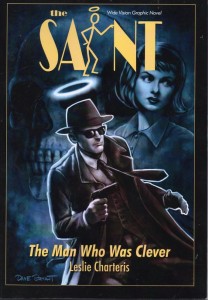Book Review: The Saint: The Man Who was Clever by Leslie Charteris, with art by Dave Bryant
Simon Templar, the Saint, was created by Leslie Charteris in the late 1920s and went on to become a major franchise. Mr. Templar (not his birth name) was a roguish young man with a murky past, and a fondness for sticking it to wealthy criminals he considered “ungodly.” He and his associates used confidence tricks, disguise and good old fisticuffs to deliver a form of justice, stealing from the crooked rich to give to the poor–minus a percentage to keep them in the style to which they were accustomed.
“The Man Who was Clever” is the earliest Simon Templar story by internal chronology; there had been others published first, but Mr. Charteris was dissatisfied with them. Although he already has the nickname of “the Saint” and his band of friends, this is the first time he publicly operates under the Saint brand, complete with his calling card stick figure.
It begins with Simon witnessing an act of brutality by a gang of small-time extortionists. But rather than jump in immediately, he investigates the gang and learns the full extent of their organization, then begins a campaign to bring not just them, but their backers as well, down. As part of this, the Saint locates the one member of the gang who’s redeemable, a basically decent fellow who has racked up gambling debt, and recruits him as a double agent.
Simon Templar is a cool customer, looking innocent (but sexy) and calm, even in the worst circumstances. He’s also a cunning planner, with only a stroke of bad timing causing any difficulty with the gambit he has in play. He’s also a good fighter, able to take down five hoodlums alone with little difficulty. (And a swordcane.)
This being written in the time period it was, Mr. Templar smokes and drinks, but is down on the harder drugs. (The villain of the piece considered himself no worse than a bartender in this regard.) There’s a bit of the xenophobia common to pulp stories of the period, with the main criminal being a foreigner who has changed his name to sound more English, and his insidious contact in Greece. The main female character, the double agent’s sweetheart, is a damsel in distress type, while Simon’s love interest Pat barely appears before being bundled off to avoid being distressed. (In other Saint stories, Pat is much more useful.)
Charming though Simon Templar is, I think he’d be hard to put up with for long in real life, with his bad poetry, annoying nicknames and endearments, and general smugness behind an innocent looking face.
The advertising calls this a “graphic novel”, but it’s really more of a heavily illustrated novella with all the original words. The illustrations are quite nice (more comic book than pulp magazine style art) but like the pulps of yore, the pictures are often nowhere near the part of the story they’re illustrating.
This is a short read (81 pages even with copious illustrations.) It’s best suited for people who are already fans of Simon Templar or other pulp characters–new readers will want to perhaps check out Enter the Saint or any of the other Simon Templar books (make sure it’s one of the ones actually by Leslie Charteris) from the library to see if they like the character before making the plunge.


Hi Scott, good for you, only 3 posts to go! MY son-in-law is into graphic novels and collects comic books. He has his own website.
http://thelongboxproject.com/ Check it out!
Hmm, there’s some good stuff there, like the “never again” post.
Cool review! I have always LOVED to watch The Saint movies—the whole Sexy Simon Templar thing……oh yeah.
As a boy, my fancy was taken by the TV episode where Mr. Templar fought a deranged toymaker.